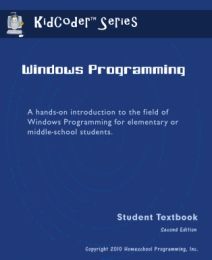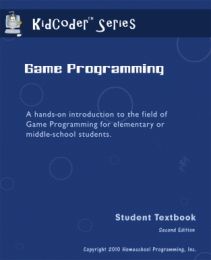
Computer programming is one of those things that I sometimes worry that my kids miss out on by being homeschooled. Part of me (the classical homeschooler and Luddite) says, "Bah! Computer programming! Who needs it?" Well, in today's world, everyone does. Thus, when a company like Homeschool Programming comes along and provides this service to my kids (and other people's kids, of course!), I am grateful.
Therese has had a little programming experience, and she really enjoyed it, so I was quite happy to be able to review KidCoder Visual Basic Series for the past couple of months. As the name implies, this course teaches kids in 6th-8th grade programming in Visual Basic.


The course is actually divided up over two semesters. Our review concentrated on the first semester, Windows Programming, which teaches students how to write "graphical Windows programs using the Visual Basic programming language." There are 14 lessons in the student text covering the following topics:
- Introduction to Computers
- Get Your Feet Wet - Learning About Visual Basic
- Exploring Visual Basic Programs
- Data Types and Variables
- Basic Flow Control
- Getting User Input
- Working with Numbers
- Working with Strings
- Using the Debugger
- Loops in Programs
- Functions
- Arrays and Structures
- Distributing Your Programs
- Putting it All Together
The text is 213 pages long. To see if your computer meets the specifications for using KidCoder, please see the Homeschool Programming FAQ. You will need both the KidCoder Textbook and a free download of Microsoft Visual Studio 2010 Express. Again, the FAQ will tell you everything you need to know about what to install and where to find it. To see an example of one of the stellar lessons (in fact, the one Therese just finished!), visit the lesson sample on the website.
Therese (12) and KidCoder
For the purpose of this review, our goal was to complete one lesson per week. Therese ended up finishing six lessons. The first lesson on computers was somewhat familiar ground for her, but it was a great way to familiarize her with the course and the terminology. It also walked her through the process of installing Visual Basic on the computer. At this point, I had to step in and help her a bit.
Lesson Two goes into using Visual Basic in a very in depth way. It assumes that the user has zero knowledge of Visual Basic, which is wonderful. The text is replete with pictures and explanations, so even though Therese has not had much in the way of computer programming (her only previous experience was with Small Basic, a kind of baby Visual Basic), she was able to begin using the program right away. This kind of immediate immersion is so important for building confidence right away when kids are working outside of their comfort zones. Big kudos to Homeschool Programming!
From there, the real fun starts. Therese started building her first project. In fact, Lesson Three began with her modifying the project she created in Lesson Two.
While nothing Therese has done in the first six lessons of Homeschool Programming has been particularly difficult, I am deliberately only having her do one lesson per week. She could do more, but I want her to take it slowly so that she has time to marinate in what she learns each week. Because she completes the lesson in a couple of hours, she ends up spending the rest of the week practicing what she has learned (usually starting the project over and seeing what she can do from memory). Here, she has taken my laptop to dance and is working on KidCoder between classes. I walked around behind her to make sure that she actually was working on school, and sure enough - she was!

Therese has enjoyed this course enough that I know that when she finishes Windows Programming, she will be anxious to move on to Game Programming, for which Windows Programming is a necessary prerequisite. This second semester course is set up very much the same as the first, with the course material containing 14 lessons and the text containing the same great graphics and step-by-step instructions. The lessons cover the following material:
- Game design concepts
- Drawing shapes on the screen
- Responding to keyboard clicks and mouse movements
- Displaying and animating images
- Object positions, movement, and acceleration
- Collision detection
- Playing music and creating sound effects
- Artificial "game" intelligence
- Saving and loading games
- Game physics
- Printing screens to the printer
The programming is, as to be expected, more in-depth, but I am confident that by the end of her present course, Therese will be able to handle it, and that she will relish the challenge. I know that as I read through the text, I couldn't wait for her to learn about these things because I knew that they would satisfy my own curiosity about how a lot of computer-y things work! I guess the real test of a good program is whether you can teach it to someone else...she's been doing a great job with Windows Programming so far, so I expect nothing less from Game Programming!
The Fine Print
Homeschool Programming's KidCoder Visual Basic Series one semester courses (Windows Programming and Game Programming) are available for $70 each. You have the additional option of adding video instruction to bring the price to $85 each. You can realize some savings by buying both courses together for $120, or both courses with videos for $145. Homeschool Programming has some other great courses for middle schoolers and teens, and the Crew got a look at several of them, so be sure to click the banner below to read a bunch more reviews.




No comments:
Post a Comment